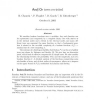Free Online Productivity Tools
i2Speak
i2Symbol
i2OCR
iTex2Img
iWeb2Print
iWeb2Shot
i2Type
iPdf2Split
iPdf2Merge
i2Bopomofo
i2Arabic
i2Style
i2Image
i2PDF
iLatex2Rtf
Sci2ools
101
click to vote
CPC
2004
2004
And/Or Trees Revisited
We consider boolean functions over n variables. Any such function can be represented (and computed) by a complete binary tree with and or or in the internal nodes and a literal in the external nodes, and many different trees can represent the same function, so that a fundamental question is related to the so-called complexity of a boolean function: L(f) := minimal size of a tree computing f. The existence of a limiting probability distribution P(.) on the set of and/or trees was shown by Lefmann and Savicky [8]. We give here an alternative proof, which leads to effective computation in simple cases. We also consider the relationship between the probability P(f) and the complexity L(f) of a boolean function f. A detailed analysis of the functions enumerating some sub-families of trees, and of their radius of convergence, allows us to improve on the upper bound of P(f), established by Lefmann and Savicky.
Related Content
| Added | 17 Dec 2010 |
| Updated | 17 Dec 2010 |
| Type | Journal |
| Year | 2004 |
| Where | CPC |
| Authors | Brigitte Chauvin, Philippe Flajolet, Danièle Gardy, Bernhard Gittenberger |
Comments (0)

